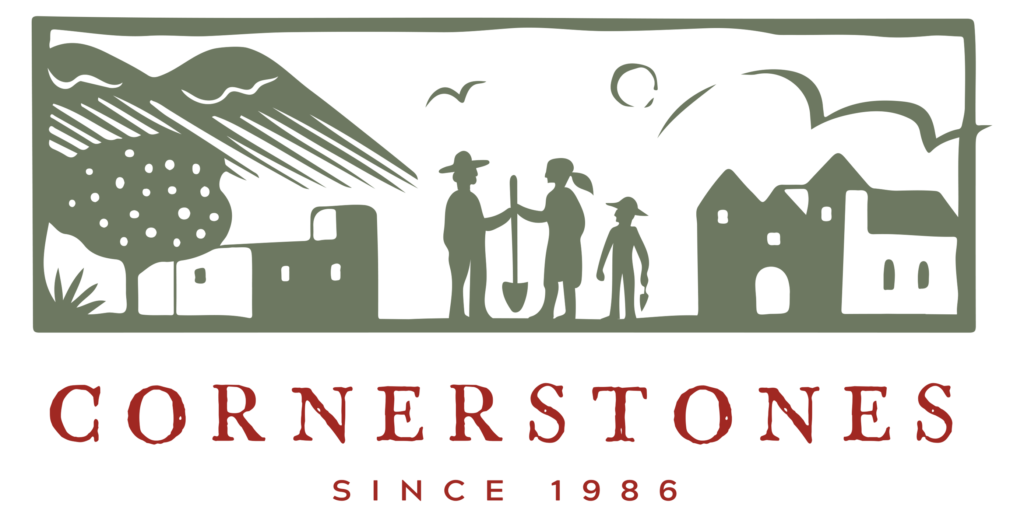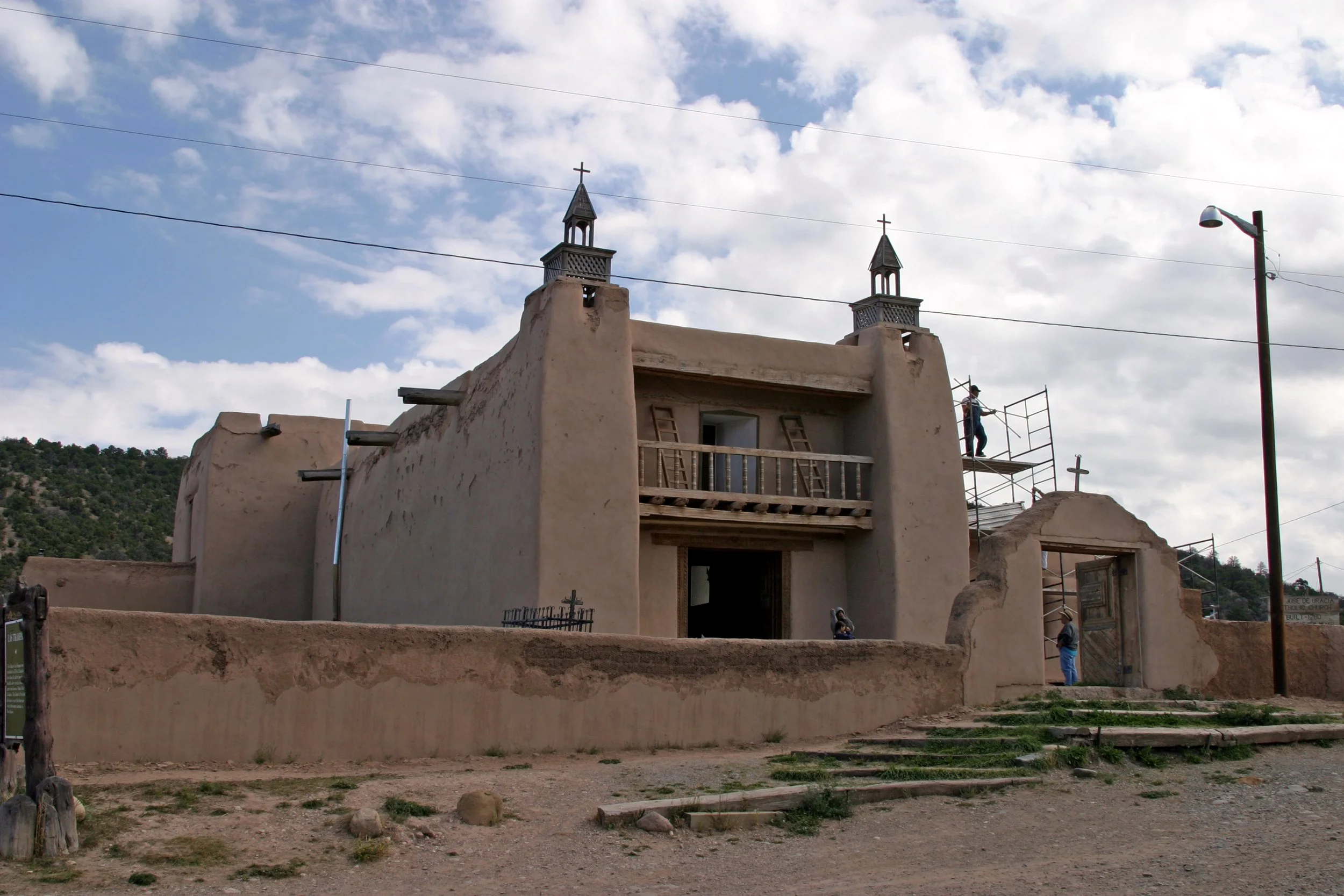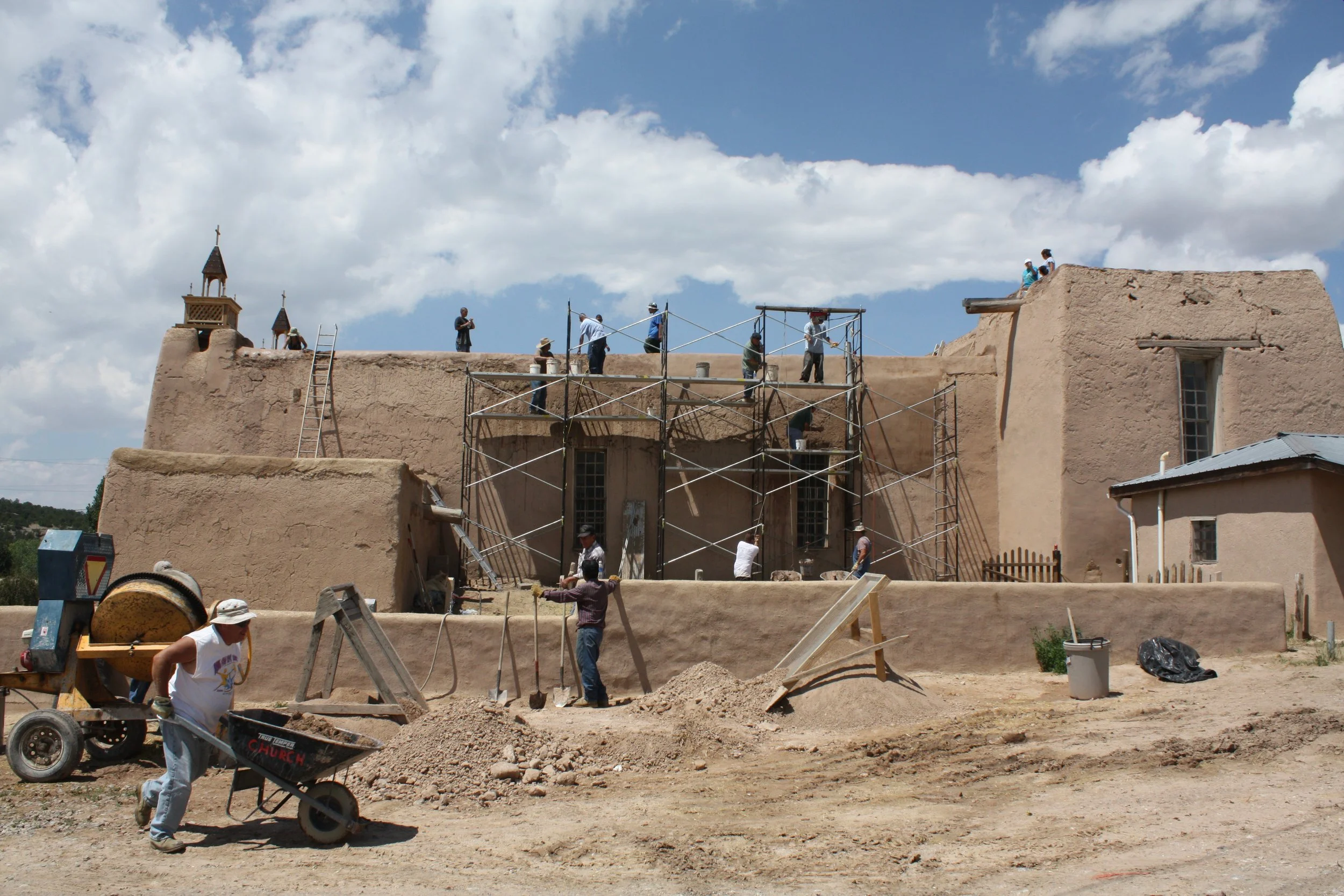Driving north on the scenic High Road to Taos with spectacular views of Truchas peaks as a backdrop, one passes through the Village of Las Trampas. On the right-hand side of the road, you can’t miss the National Landmark San Jose de Gracia Mission Church that sits prominently in the Village of Las Trampas, itself a National Landmark District. The patina of age radiates from this Church. The adobe walls are weathered. But its prominent size, design, and location along this mountainous highway arrest any passersby. Travelers often stop, take pictures, and go to the locked door, wishing to enter. In times past, Jose Lopez—a frequent Mayordomo and elder who lived just opposite from the Church—would often come out to open the door. He graciously entertained visitors and responded to their questions and comments. The north windows in his house lookout at San Jose, and he had a habit of glancing that way anytime he passed those windows. Jose’s connection to San Jose was about as deep as a connection to a building could be. It was in his blood. He was and is not the only one.
I had passed San Jose de Gracia in 1972 for the first time on my way to the mountain Village of El Valle, located along the Rio de Las Trampas. The Rio descends from Truchas peaks down the valley passing through the Village of Las Trampas. My first encounter with the Las Trampas community was later, in 2009, when I began working at Cornerstones Community Partnerships. Sorting through the inbox, I discovered we had been awarded a grant from the National Park Service Heritage Preservation Program to help preserve the San Jose de Gracia Church. With not much to go on, I called the parish office of the Holy Family Church in Chimayo. I connected with Pat Oviedo, the Chief Financial Officer of the parish that includes San Jose de Gracia. She was unaware of the grant and suggested I speak with a community elder to see how the funds could help maintain the Church. Following her suggestion, I got in touch with Emilio Martinez, a community elder who rotated into the Majordomo role from time to time. Mayordomos are the keeper of keys for the churches. They carry on the tradition. They are the authority that has jurisdiction over the maintenance of the church. This tradition extends back to the Spanish colonization of the Americas.
Emilio was not especially pleased to hear about the grant. He was surprised to hear the government was offering funds for the preservation of the Church—without anyone in the community knowing about it. Since I was new on the job at Cornerstones, I could profess ignorance (which was accurate). I suggested he and I work together to find a good use for the funds. I sensed Emilio was thinking, “here we go again: outsiders coming to las Trampas with aid, help or advice.” Driving away, I felt like the gringo crossing a stream of thin ice going from “Anglo world” to “Norteño world” and not being too sure of the safe steps across. Cornerstone’s mission provided the solace to try to make it across to the other side. For the check of the grant to be released, a need, a proposal, a budget, and responsible parties were the I’s and t’s of the bureaucratic freezing river I needed to cross.
A process of dialogue ensued in which these questions were converted to governmental lingo and the funds were released. The process involved others in the community, including Rosemary Vigil and Frank Lopez Jr. Goals included some infrastructure to be repaired under contract and a largely volunteer effort focusing on adobe repairs, mud plastering the Campo Santo walls, and plastering major sections of the Church walls. A schedule was set, and volunteer days were announced. Cornerstones provided scaffolding and a mixer for the project.
I volunteered, and on the first day, Emilio directed me to a large pile of dirt, the adobe dirt screen, handed over a shovel, and walked away. I figured I knew how to do it and started throwing dirt through the screen. Pretty soon, Emilio was back. He smiled, took the shovel, and demonstrated the flicking technique, tossing towards the top and not letting the shovel impact the screen. I began to appreciate the fact that such a simple task could have important nuances I had here to fore not considered. I was in learning mode, and it felt good having been a supervisor for so many years.
Volunteers began to stream in, and as the day progressed, I could see that this was both a work experience for some but a social event for all. A meal was served in the Morada behind the Church, and the day captured the essence of community gathering for a joint purpose. My second learning experience was working alongside community elder enjarradoras (women who traditionally did the plastering). Three senior women were mudding a section of the Campo wall. They were willing to let me help. Their dialogue was almost entirely in Spanish, so observation again was key to learning. What appeared to be a simple process of tossing a handful of mud on the wall and following with a swipe of the palm of the hand was anything but simple. They were very patient with me and eventually I managed the fundamentals.
These set days, usually Saturdays, extended into weeks as the work progressed. Eventually, we were on to the Church walls with routines and regulars established. One day the volunteer group was particularly large. That day was the day that word had spread around through the grapevine about the work at Las Trampas and extended relatives, descendants, and a few low riders assembled in the parking lot and around the Church. The cultural connectivity was heavily loaded up in the atmosphere of Las Trampas on that occasion.
These set days, usually Saturdays, extended into weeks as the work progressed. Eventually, we were on to the Church walls with routines and regulars established. One day the volunteer group was particularly large. That day was the day that word had spread around through the grapevine about the work at Las Trampas and extended relatives, descendants, and a few low riders assembled in the parking lot and around the Church. The cultural connectivity was heavily loaded up in the atmosphere of Las Trampas on that occasion.
One day while in my Santa Fe office, a stranger knocked on the door and asked if he could talk about volunteering. He introduced himself to me with the usual conversation niceties. Gradually, it came out that he was a vet suffering from PTSD due to experiences in Iraq and Afghanistan. He wanted to do something simple and straightforward. Something meaningful. At that very moment, I was writing up the work in Las Trampas. In this moment of synchronicity, I asked how he’d feel about participating in the work up there. I explained the mud plastering process and the importance of San Jose de Gracia. Being New Mexican he knew something about it. He considered and asked to be contacted if it turned out to be possible. As soon as he left, I called Pat at the Parish office to see how they’d feel about such a troubled individual and a non-community member helping out. No one objected—in fact, they were very welcoming. I made arrangements with the vet. After a few weeks, a little nervous, I called to check in and learned the community had embraced him. And he seemed to really enjoy the work. Later he called to thank me—saying few experiences had helped him as much as mudding those walls with the community. His comments reinforced the idea that mud plastering the adobe mission churches can be more than just a typical day of manual labor. Putting that mud on the wall after so many have gone before, repeating this very old tradition to extend the life of the mission, builds community. This ancient process has faded but remains alive. The vet connected those dots.
Five years later, in 2014, I worked with Pat to apply for a grant from the Historic Preservation Division of the State Office of Cultural Affairs, to produce a preservation plan for San Jose de Gracia. Typically experts in historic preservation produce preservation plans. For this grant, Cornerstones decided to instead try to involve the community as much as possible. The challenge was to find professionals connected to the heritage of the place. Another goal was to bring elders into the conversation thereby honoring the legacy of their ancestors. The community had grown tired of outside “experts” advising how best to care for their church. So, we found a community photographer for documentation; another community member oversaw the architecture; another researched written documentation; another was a local editor. Those choices meant that the preservation specialist from outside the community only reconciled issues with the Secretary of Interior's Standards for Historic Preservation—key to receiving the State-awarded grant.
The challenge is to reconcile these preservation requirements with the living building and the community ties it has fostered. One, like San Jose, has evolved over centuries with interventions made by those who are connected there, both in the original construction and then succeeding years as decedents assumed their responsibility for it. One has to ask about the jurisdiction of such a place and who has the right to make determinations. Tensions can arise while adapting larger notions of historic preservation to fit community hopes, expectations, and building uses.
One of the most gratifying experiences of the project was walking with Jose Martinez around the grounds of the Church as he pointed to and explained many features of the building. It was like walking with a kindly professor sharing his accumulated knowledge of his favorite subject. We went through the nave, into the sacristy, up into the choir loft, and to the balcony. We discussed the issues of the differential fill outside on the north wall of the baptistry where moisture problems have been persistent. In this room, now a baptistry, he pointed out little dark reddish spots on the upper wall and ceiling, explaining that it was the blood of the penitentes from a time when the hermanos practiced flagellation. Seeing this brought home a vivid recognition of something I had only ever read about.
We concluded our assessment tour in front of the Church looking at a white cross painted on the exterior of the balcony door. Jose said, “I painted that cross on there because sometimes a high wind would blow the door open and I couldn’t see that from my window. With the white cross there, I can tell if the door is blown open or not.” I thought to myself that a strict reading of the Secretary of the Interiors Standards wouldn’t allow such an alteration. I let the thought go.
Jose passed away on May 15, 2018. I attended his funeral service at San Jose de Gracia. The Church was so crowded it wasn’t possible to get inside. The sanctuary was packed with family members and friends. From outside, I listened to the Priest’s comments about Jose’s devotion to San Jose. I felt honored to have known him. We dedicated the Cornerstones 2017 Annual Report to him. In the cover photo, Jose stands in front of his church. A dignified elder in front of the similarly aging church. While he has passed, San Jose de Gracia lives on for others to step in his shoes to continue the work.
After notes
San José de Gracia Church in Las Trampas, NM was built between 1760 and 1776. The Church ceiling is painted with 18th- and 19th-century motifs. It features 18th and 19th-century Santeros and is on the U.S. National Register of Historic Places and is a U.S. National Historic Landmark census records show two families living in Las Trampas in1751. Both the Church and the district are National Historic Landmarks.
San José de Gracia is New Mexico’s best-preserved example of both vernacular building practices and eighteenth-century Spanish Colonial ecclesiastical architecture.
Built of adobe with a hand-plastered mud exterior, its walls are 4 to 6 feet thick and about 30 feet high. The structure is roofed by large vigas that rest on corbels set into the walls and are covered with split cedar planks (rajas) and several feet of packed earth.
The Church was repaired and stabilized by the Committee for the Preservation and Restoration of New Mexican Churches in 1932 when it received new roof timbers, new tower bases, and a new balustrade and beam for the balcony. In 1970, after being designated a National Historic Landmark to prevent its alteration by the widening of New Mexico State Highway 76, the Church was re-plastered, re-roofed and its wooden belfries were restored to their original appearance based on a design by John Gaw Meem.





